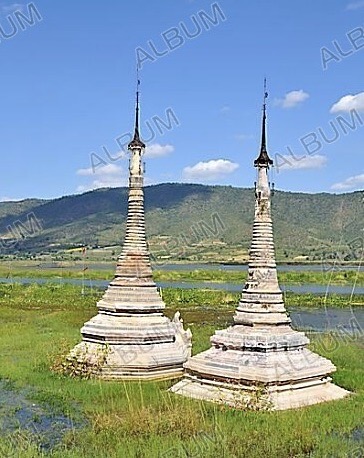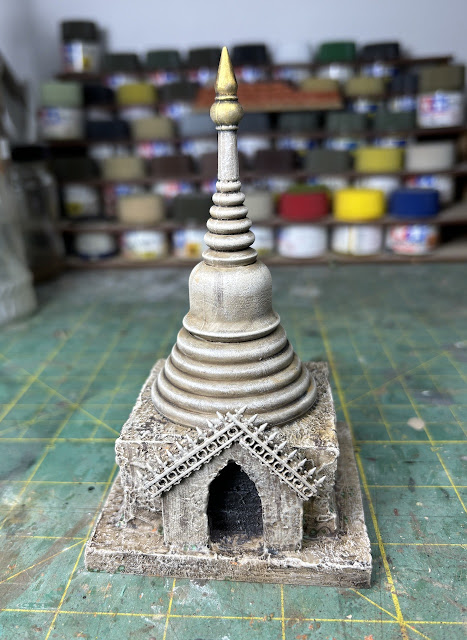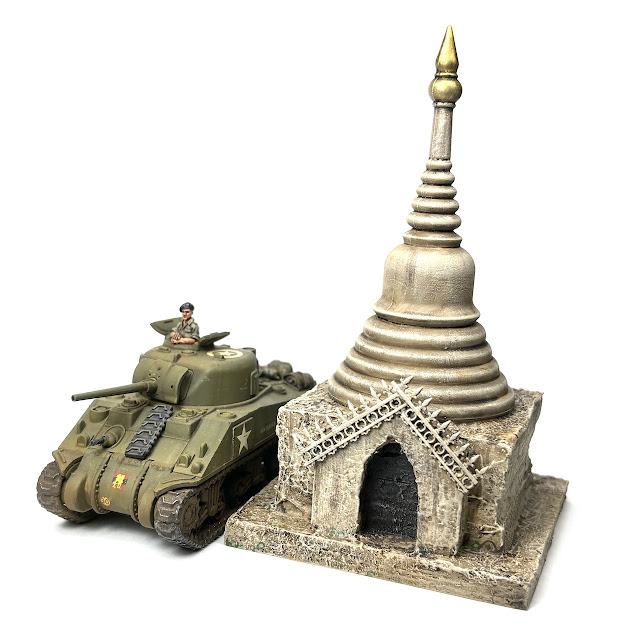During Operation Thursday, the second Chindit mission, Brigadier Mike Calvert was tasked with forming a block of the railway and motor road near Henu at a site that would become famous as White City. Before the block could be established Japanese garrison troops had to be cleared from the area. One particular action, during which Calvert led a bayonet charge, was the taking of a hill with a pagoda on the top which unsurprisingly was nicknamed 'Pagoda Hill'. I've wanted to create that action on the table top and started searching around for a suitable pagoda as a terrain piece.
I began the obligatory online search looking for what I thought would be a Japanese/Chinese style pagoda. It looks like I was searching for the wrong thing. What the British often referred to as a pagoda is in fact a Buddhist structure known as a stupa, a very common sight in the Burma/Thailand region. Looking at contemporary photographs they are clear to see.
How did I discover this? Well, I have to give credit to Veroo who runs the blog For a Few Rounds More without whom I'd still be scrolling through the aquarium section on eBay for Chinese style pagodas.
Stupa vary in size depending on location, so that the Shwedagon Pagoda in Yangon (formerly Rangoon) is a massive structure rising to 127m high and dominating the skyline of the city much like the spire of a medieval cathedral might do in Europe.
On the other hand much smaller ones can be found scattered across the country by roadsides and in towns and villages.
Some are not unlike the roadside calvary you might see in France. I already had a model of one of those I put it together for the opening scenario in the Operation Martlet campaign for Chain of Command (it's a 3D print from Sabotag3D). Now I needed the Buddhist equivalent for Burma.
As always a search becomes much easier when you know what you are actually looking for. From what I've come to understand (and if I've got this wrong please forgive me) a stupa is traditionally used to house some form of sacred or significant relic. Entry is usually reserved for priests.
They are important objects in Buddhist culture and miniature versions are used at home in the belief they remove negative karma and assist in the journey to enlightenment. A quick search on eBay or Aliexpress will turn up many in acrylic for a very reasonable price. So I have to confess that I've acquired three of these miniature stupa for something far more pedestrian than spiritual enlightenment. They may not bring nirvana to my wargame terrain but I hope they will bring an element of authenticity.
They measure 80mm high which seems about right for my 20mm figures and the fairly rural settings where I expect to be using them.
I decided to use one as the basis for a slightly larger structure using the contemporary images I have seen for inspiration. The initial base was built up using cork floor tiles.
The small entrance was cut from another piece of cork.
Household filler was used to try to hide the joins in the cork and add a bit of texture.
The acrylic stupa was then glued on top using PVA glue.
I wanted to add the decorative features that adorn these entrances and rummaged through my terrain spares box for something suitable. I have these plastic cast iron fences from a model railway fence set and I thought I could trim a section off one of those.
With assembly complete the whole thing was primed.
Then it was simply a matter of painting with a Dulux emulsion and touching it off with VMC Gold on the tip of the spire. I then gave everything a wash with Agrax Earthshade.
If you've found this post useful and would like to Buy Me a Coffee to help cover some of the costs of running the blog you can click through at the link or on the tab in the right hand column of this page.



























Brilliant!
ReplyDeleteThanks Phil.
DeleteWonderful work from photo to table item. As already said, brilliant!
ReplyDeleteThank you!
DeleteExcellent!
ReplyDeleteThanks Carole - simple, but effective I think.
DeleteVery impressive, way above and beyond what my own shoddy hands are ever capable of! Thank you also for the shout-out. Interestingly enough you can actually get tabletop-ready Bagan-style temples from aquarium stores - be sure to give that a look!
ReplyDeleteYou do yourself a disservice, lots of very nice pieces on your blog and a great inspiration. I've almost bought some French colonial figures but resisted the temptation!
Deletefantastic work
ReplyDeleteThanks!
DeleteVery clever and effective!
ReplyDeleteThanks, sometimes simplicity is the key.
DeleteVery nice, although I think it would benefit from a bit of foliage growing up it.
ReplyDeleteI have to wonder if this is all displacement activity designed to avoid your final confrontation in the Martlet campaign? ;o)
It depends on location - generally they appear to be well kept, the only places I've seen them overgrown with foliage is in deserted historical sites. As for Martlet Dave and I were only talking about it last night at the club. Work has interfered for him but hopefully we get back to it the week after next.
DeleteGreat work, superb build, really very good indeed.
ReplyDeleteThank you!
DeleteNicely done! A perfect size for tabletop use.
ReplyDeleteThanks, that's what I thought too.
DeleteThat is a really cool bit of terrain - I want one too now - and I dont even game WWII in the Far East! (Although, come to think of it, I do have a fairly large Japanese force in 15mm.....hmmm!)
ReplyDeleteAs Mark says, scale is irrelevant as they'd look accurate regardless of figure size: https://afewroundsmore.wordpress.com/wp-content/uploads/2021/06/dscf5385.jpg
DeleteGiven their different sizes it's not really a scale specific piece - it's a big stupa for 15mm and a smaller one for 28mm. You can't go wrong!
ReplyDeleteClever Mark
ReplyDeleteVery nice indeed.
ReplyDeleteThat´s a really great looking piece of terrain!
ReplyDelete